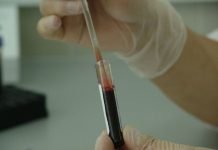
CHICAGO, Nov. 6 (UPI) — Testing blood for soluble urokinase-type plasminogen activator receptor, or suPAR, can predict a patient’s risk of developing chronic kidney disease, or CKD, as early as five years before damage from the condition is seen, according to a new study.
Researchers compare finding the significance of suPAR to discovering the role that testing cholesterol levels now plays in diagnosing cardiovascular disease. CKD affects more than 15 percent of people in the United States and causes about 47,000 deaths per year. Most people do not know they have it until the disease is advanced. The symptoms of chronic kidney disease — blood in the urine, swollen hands and feet, and excessive thirst — usually don’t show up until severe damage has been done to organs.
The two markers used for CKD, measuring creatinine levels in the blood and protein levels in urine, can help doctors monitor the condition, but they are not sensitive enough to catch the disease early or predict risk for its development.
“The observation that high suPAR levels predict the future development of chronic kidney disease in different populations suggests this molecule may be a target for treatment to improve clinical outcomes in the majority of patients at risk for future kidney disease,” said Dr. Howard Trachtman, a pediatric nephrologist at NYU Langone Medical Center, in a press release. “Blocking suPAR may prove to be comparable in its application to the use of angiotensin converting enzyme inhibitors and angiotensin receptor blockers which are among the few drugs approved for treatment of chronic kidney disease.”
Researchers analyzed renal function in 2,292 people participating in the Emory Cardiovascular Biobank between 2003 and 2009 who had a mean age of 63 and 65 percent of whom were men. Participants were measured for suPAR and creatinine levels at the start of the study and in follow-ups.
The data showed 40 percent of participants had high suPAR levels and creatinine levels that did not indicate CKD, but went on to develop the condition during the next five years. Just 10 percent of participants with low suPAR levels developed the condition.
While suPAR levels alone can show the risk for developing CKD, researchers said other risk factors must be explored, and more research with larger and more diverse groups of patients will be needed to refine the test for common use.





